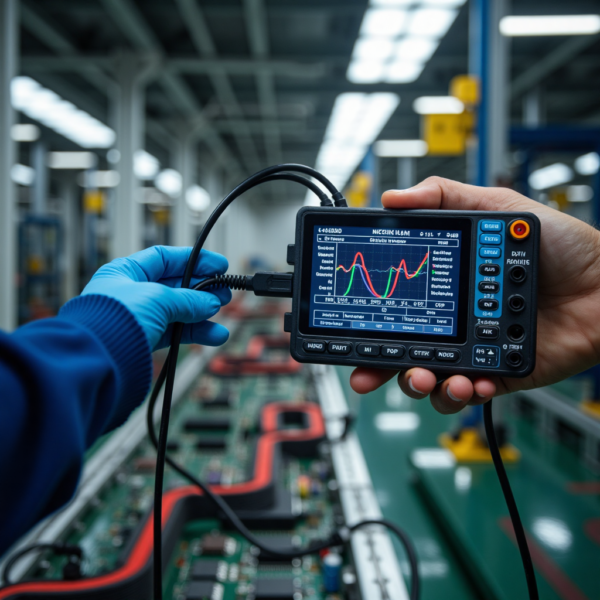Engineering Calculation Method for Cable Cross-Section Selection in New Energy Systems

Table of contents
- Engineering Calculation Method for Cable Cross-Section Selection in New Energy Systems
Ⅰ. Calculation Based on Current Carrying Capacity
In the cable selection for new energy systems (such as photovoltaic, wind power, and energy storage), current carrying capacity is the most critical calculation basis, directly affecting the safety and reliability of the system. The main calculation methods include continuous current-carrying capacity method and temperature rise verification, which must be adjusted based on environmental conditions and installation methods.
1.1 Continuous Current-Carrying Capacity Method
(1) Basic Calculation Formula
The minimum cross-sectional area of the conductor AminAmin (mm²) is determined by the load current II (A) and the allowable current density JJ (A/mm²): Amin=I/J
The current II is calculated based on the system type:
▪ Single-phase AC system: I=P/(V×cosϕ)
▪ Three-phase AC system: I=P/(3×V×cosϕ)
▪ DC system (e.g., PV modules): I=P/V
Typical current density JJ values:
The Copper conductor: 4~6 A/mm² (can be extended to 8~10 A/mm² for short-term operation).
Aluminum conductor: 3~5 A/mm².
(2) Current-Carrying Capacity Correction Factors
In practical engineering, adjustments must be made based on installation environment and cable type, referring to standards (e.g., IEC 60287, GB/T 16895.6):
• Ambient temperature: Derating is required in high-temperature environments (e.g., above 40°C, multiply by 0.8~0.9).
• Installation method: Air installation: Better heat dissipation, higher current-carrying capacity; Buried or cable tray installation: Poor heat dissipation, reduced current-carrying capacity (e.g., multiply by 0.7~0.8 for direct burial).
• Multiple parallel cables: Consider mutual heating effects (multiply by 0.8~0.9).

1.2 Continuous Current-Carrying Capacity Method
The temperature rise of cables during long-term operation must not exceed the allowable value of the insulation material; otherwise, it may accelerate aging or even cause fires.
(1) Temperature Rise Verification
TI2RΔt=CmΔT
R: Conductor resistance (Ω). Δt: Duration of current flow (s). C: Specific heat capacity of conductor (J/(kg·℃)). m: Mass of conductor (kg).
ΔT: Allowable temperature rise (e.g., ≤70°C for PVC insulation, ≤90°C for XLPE).
(2) Dynamic Condition Corrections
High-frequency current (e.g., inverter output): Consider skin effect, increase conductor size or use stranded wires.
Intermittent loads (e.g., energy storage PCS): Calculate based on RMS equivalent heating current.
1.3 Engineering Selection Example
Case: A PV power station with string current of 10A, ambient temperature of 40°C, PVC-insulated copper cable, and direct burial installation.
• Calculated current: 10A (no power factor correction needed for DC side).
• Current-carrying capacity correction:
▪ Standard current-carrying capacity (25°C): ~36A for 4mm² copper cable (in air).
▪ Temperature correction (40°C): ×0.89 → 32A.
▪ Burial correction: ×0.7 → 22.4A.Standard current-carrying capacity (25°C): ~36A for 4mm² copper cable (in air).
• Conclusion: 4mm² meets requirements (10A < 22.4A).
Summary
When selecting conductor size based on current-carrying capacity:
• Calculate load current.
• Preliminary selection of cross-sectional area and verification of current-carrying capacity.C side).
• Apply corrections for environment and installation method.
• Perform temperature rise verification if necessary.

Ⅱ. Voltage Drop Limitation Calculation
In new energy systems, voltage drop is a critical factor affecting power transmission efficiency. Excessive voltage drop can cause equipment malfunction (such as PV inverter MPPT failure), increase power loss, and even impact system stability. Therefore, cable selection must ensure the voltage drop remains within allowable limits.

2.1 Allowable Voltage Drop Standards
Typical voltage drop limits for different applications:
• PV DC side: ≤3% (NEC 690.7)
• AC grid-connected side: ≤5% (GB/T 12325)
• Energy storage charge/discharge circuits: ≤2% (stricter for high-current scenarios)
2.2 DC System Voltage Drop Calculation
(1) Basic Formula
ΔU=(2×I×L×ρ)/A
ΔU: Voltage drop (V) I: Operating current (A) L: Cable length (m) ρ: Conductor resistivity (copper 0.0178Ω·mm²/m, aluminum 0.0283Ω·mm²/m) A: Conductor cross-sectional area (mm²)
(2) Percentage Voltage Drop
ΔU
Example: PV string current 10A, voltage 600V, cable length 50m, using 4mm² copper cable: ΔU=(2×10×50×0.0178)/4=4.45V(ΔU
2.3 AC System Voltage Drop Calculation
(1) Simplified Formula (Ignoring Reactance)
ΔU
K: Coefficient (2 for single-phase, √3 for three-phase) cosφ: Power factor (typically ≥0.95 for new energy systems)
(2) Long-Distance Lines Considering Reactance
For high-voltage or long cables, inductive reactance must be included:
ΔU=I×(Rcosφ+Xsinφ)
R: Resistance per unit length (Ω/km) X: Inductive reactance per unit length (typically 0.08~0.12Ω/km)

2.4 Engineering Optimization Methods
(1) Cross-Section Adjustment
If voltage drop exceeds limits, prioritize increasing cable size. Example:
• Original 6mm² copper cable with ΔU%=4.5% → Change to 10mm², ΔU% reduces to 2.7%
(2) Segmented Compensation
Boost transmission: Use higher string voltage on PV DC side (e.g., 1500V system reduces voltage drop by 33% compared to 1000V system)
Reactive power compensation: Install SVG or capacitors for long AC lines
2.5 Case Application
Initial selection: 240mm² aluminum cable
R=0.125Ω/km, X=0.1Ω/km
ΔU=100×(0.125×0.95+0.1×0.31)=14.2V(ΔU
Conclusion: Meets requirements (far below 5% limit)
Summary
Steps for cable sizing based on voltage drop:
• Determine system type (DC/AC) and allowable ΔU%
• Calculate initial voltage drop and verify compliance
• Adjust cable size or optimize topology (e.g., shorten distance, boost voltage)
• Special scenarios (e.g., long distance, high reactance) require combined reactance verification

Ⅲ. Short-Circuit Thermal Stability Verification
In new energy power systems, short-circuit faults may generate enormous instantaneous currents. If the cable cross-section is insufficient, it can cause conductor overheating or even melting, leading to safety accidents. Therefore, short-circuit thermal stability verification is essential to ensure cable safety under fault conditions.

3.1 Impact of Short-Circuit Current on Cables
When a short-circuit occurs, cables withstand currents far exceeding rated values within milliseconds (typically 0.1-1s), with main effects including:
• Conductor heating: Joule heating (I²Rt) causes rapid temperature rise, potentially damaging insulation.
• Mechanical stress: Electromagnetic forces from high current may deform or break cables.
3.2 Minimum Thermal-Stable Cross-Section Calculation
(1) Basic Formula (IEC 60909)
ΔAmin=(Ik×√t)/K
A_min: Minimum conductor cross-section (mm²)——I_k: Effective short-circuit current (kA)——t: Short-circuit duration (s), typically protection device operating time (e.g., 0.2s for circuit breakers) ——K: Material coefficient (copper 143, aluminum 95, steel 46)
(2) Allowable Temperature Rise Limits
PVC-insulated cables: Conductor temperature ≤160°C during short-circuit
XLPE-insulated cables: Conductor temperature ≤250°C during short-circuit

3.3 Calculation Steps and Example
(1) Determine Short-Circuit Current
Obtain through system short-circuit capacity calculation or simulation software (e.g., ETAP). Typical new energy scenarios:
• PV plants: 5-20kA (DC side current limited by modules)
• Wind farms: 10-50kA (transformer output side)
(2) Case Calculation
Energy storage system AC side: I_k=15kA, breaker operating time t=0.5s, copper conductor:
ΔAmin=(15×√0.5)/143=0.74mm2
Actual selection: Consider current-carrying capacity and mechanical strength, typically select ≥2.5mm².
3.4 Special Scenario Considerations
(1) DC System Short-Circuit (e.g., PV Strings)
Short-circuit current limited by module I_mp (typically 1.2-1.5× rated current), but still requires verification:
ΔAmin=(Isc×√t)/K
I_sc: String short-circuit current (e.g., 15A for 10A string)
(2) High-Frequency Short-Circuit (e.g., Inverter Output)
Consider skin effect, increase cross-section or use multi-strand conductors.
3.5 Engineering Application Key Points
Coordination with protection devices: Short-circuit duration t must be less than protection device operating time.
Economic balance: Prioritize thermal stability for HV cables (e.g., 35kV collection lines), LV cables may consider current-carrying capacity.
Standard reference: GB/T 12706, IEC 60502 specify short-circuit withstand requirements.
Summary
Short-circuit thermal stability verification is the safety baseline for new energy cable selection:
• Calculate system short-circuit current
• Determine minimum cross-section using formula
• Verify with insulation material temperature limits
• Determine system type (DC/AC) and allowable ΔU%

Ⅳ. Economic Current Density Method
In new energy system engineering, the economic current density method is an important cable selection approach that balances initial investment with long-term operational losses. It is particularly suitable for high-voltage transmission lines and wind farm collection systems with large capacities and long operating hours.

4.1 Basic Concepts and Principles
(1) Definition of Economic Current Density
The current density value (A/mm²) that minimizes total investment cost (including construction and operational losses) over the cable’s lifecycle
Mathematical expression:
Jecon=((C0∗α)/(C1∗τ∗ρ))(1/3)
C_0: Unit length cable cost (¥/m)——C_1: Electricity price (¥/kWh)——α: Capital recovery factor——τ: Annual maximum load loss hours——ρ: Conductor resistivity
(2) Typical Value Ranges
| Conductor Type | Economic Current Density (A/mm²) |
| Copper | 1.5~2.5 |
| Aluminum | 0.9~1.6 |
4.2 Calculation Steps
Determine maximum operating current I_max
Select economic current density J_econ (adjusted based on local electricity prices and load characteristics)
Calculate economic cross-section:
Aecon=Imax/Jecon
Round to standard specifications (e.g., 95/120/150mm² per GB/T 3956)

4.3 Application Characteristics in New Energy
(1) Wind Farm Collection Lines
Typical J_econ=1.2A/mm² for 35kV collection lines
Example: 20MW wind farm, 35kV side current 330A:
Aecon=330/1.2=275mm2→select300mm2aluminumcable
(2) PV Step-up Lines
Consider daily generation fluctuations, use lower J_econ values
1500V systems can reduce cross-section by ~30% compared to 1000V systems

4.4 Lifecycle Cost Analysis
| Cost Type | Calculation Formula | Description |
| Initial Cost | C_0 * L * A | Includes cable and installation |
| Operational Loss | 3I²RτC_1 | Calculated with 20-year discount |
| Optimal Solution | dC_total/dA = 0 | Derives economic current density |
4.5 Engineering Considerations
Load factor correction: For systems with <4000 annual operating hours, increase J_econ by 10~15%
Electricity price sensitivity: Every ¥0.1/kWh price increase requires 5~8% larger cross-section
Special environments: Offshore wind requires additional anti-corrosion cost considerations for J_econ
Summary
The economic current density method provides optimal cable sizing for new energy systems by quantifying total lifecycle costs. Practical engineering requires:
• Parameter adjustment based on local electricity policies
• Selecting maximum values from voltage drop and short-circuit capacity verifications
• Adding 10~15% margin for critical circuits
Note: This method is most suitable for new energy transmission lines ≥10kV with >3000 annual operating hours. For low-voltage systems, current-carrying capacity should be prioritized.
Ⅴ. Mechanical Strength and Installation Conditions
In new energy cable selection, mechanical strength and installation conditions often become critical factors determining conductor size, particularly in complex environments (e.g., offshore wind farms, desert PV plants) requiring special consideration. This section systematically analyzes mechanical strength requirements and standard selection criteria for typical installation scenarios.

5.1 Basic Mechanical Strength Requirements
(1) Minimum Allowable Cross-Sectional Area
| Application Scenario | Minimum Cross-Section | Standard Reference |
| Overhead insulated conductor | Cu≥16mm², Al≥25mm² | GB/T 1179-2017 |
| PV DC side cables | Cu≥4mm² (mechanical protection) | IEC 62930 |
| Vertical installation in wind turbine towers | Multi-core cable≥6mm² | GB/T 12706.1-2020 |
(2) Tensile Strength Verification
Overhead lines: Must satisfy maximum tension condition
Tmax=(W×S×F)/K
W: Weight per unit length (kg/m)——S: Span length (m)——F: Safety factor (≥2.5)——K: Strength margin coefficient (1.2~1.5)
5.2 Typical Installation Methods and Size Adjustment
(1) Overhead Installation
Wind load impact: Increase 1-2 size grades in typhoon-prone areas
Sag calculation: Adjust conductor size by span (e.g., 15% larger cross-section for 500m span vs 100m span)
(2) Direct Burial
| Soil Condition | Current-Carrying Capacity Facto | Mechanical Protection Requirements |
| Ordinary clay | 0.8~0.9 | Armored layer + protection board |
| Rocky terrain | 0.7~0.8 | Galvanized steel pipe protection |
| Corrosive soil | 0.6~0.7 | Anti-corrosion armor (e.g., PE sheath) |
(3) Cable Tray Installation
| Installation Layers | Current-Carrying Capacity Factor |
| Single layer | 1.0 |
| Double layer | 0.85 |
| Three or more layers | 0.75 |

5.3 Special New Energy Applications
(1) Offshore Wind Power
Dynamic cables: Must satisfy >25 years wave load fatigue life
WTypical specifications:
graph LR
A[220kV main cable] –> B[Cross-section≥800mm²]
B –> C[Double armor + lead sheath]
(2) Desert PV
Sand erosion resistance design:
• Increase outer sheath thickness by 0.5~1mm
• Adopt MC-type (anti-twist) cable structure
5.4 Bending Radius Standards
| Cable Type | Minimum Bending Radius | Example (20mm OD) |
| Single-core cable | 20×OD | ≥400mm |
| Multi-core cable | 12×OD | ≥240mm |
| Fiber composite cable | 30×OD | ≥600mm |
5.5 Engineering Selection Case
Project Background: High-altitude PV plant (3000m elevation, 40℃ diurnal temperature variation)
• Selection process:
• Preliminary selection: 4mm² copper cable (based on current capacity)
• Correction factors: UV radiation: Upgrade to UV-resistant sheath;Thermal stress: Increase to 6mm²;Rodent protection: Add metal armor layer
• Final specification: 6mm² rodent-proof armored copper cable
Summary
The economic curreKey points for mechanical strength and installation verification:
• Prerequisite: Meet basic conductor size from current/voltage drop calculations
• Environmental adaptation: Select protective structures (armor/anti-corrosion etc.) based on installation method
• Dynamic verification: Special mechanical analysis required for dynamic scenarios like wind power
• Standard compliance: Strictly follow GB/T 12706, IEC 60228 etc.
Note: For critical circuits (e.g., 220kV submarine cables), finite element analysis is recommended for mechanical stress simulation.

No comments to show.




Leave a Comment